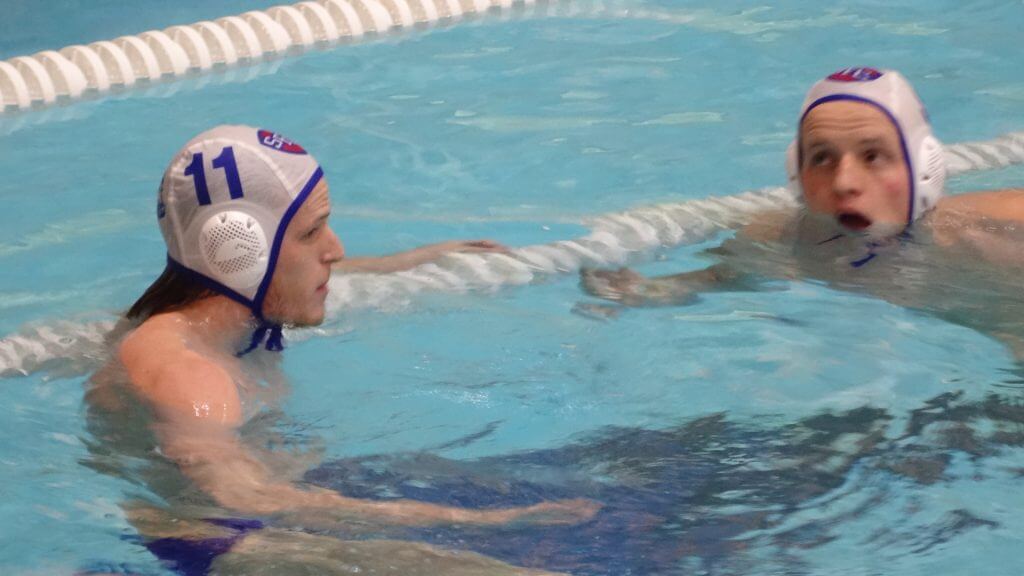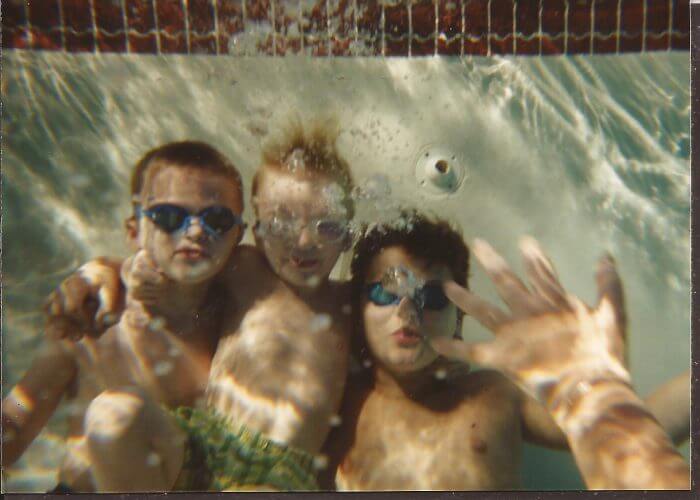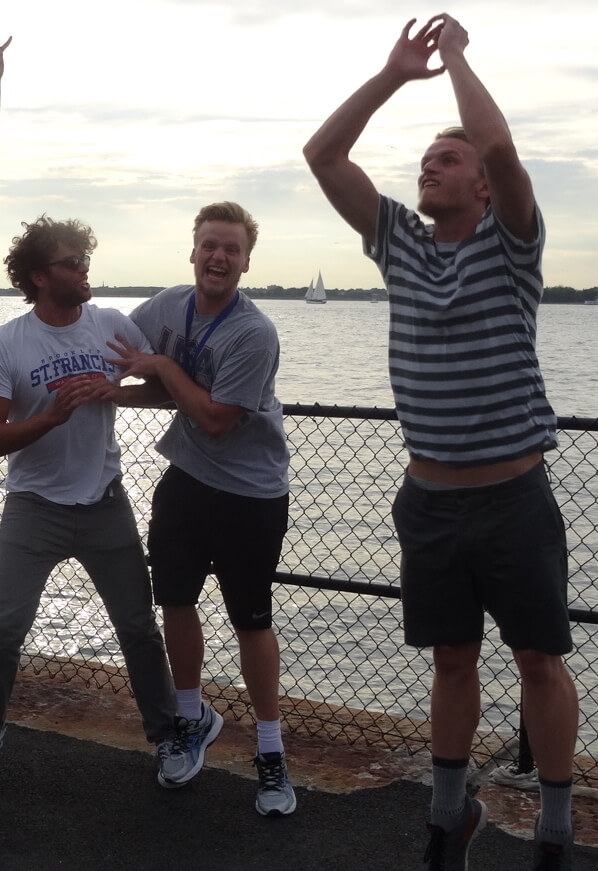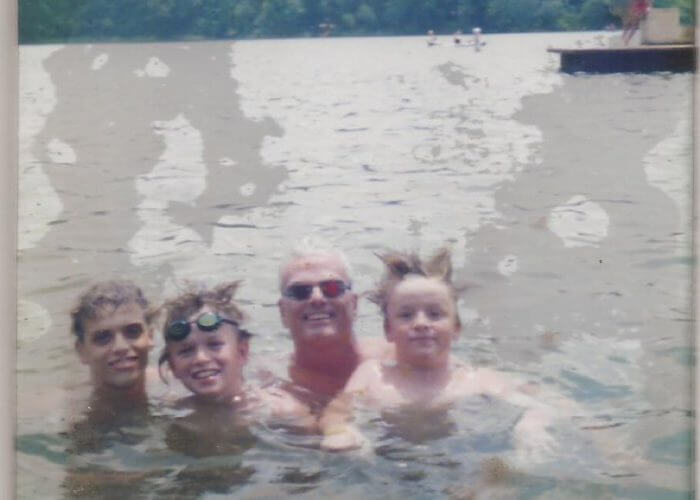The Veazeys of Dallas: How A Swim Family Fell for Water Polo

by Michael Randazzo, Swimming World Contributor.
Liam Veazey was once considered one of the best young swimmers in the state of Texas. A top finisher in 2001 and 2002 at Texas Age Group Swimming (TAGS) Championships, by 2010, despite endless hours in the pool in a futile quest to “drop time,” Veazey had hit a wall. He simply couldn’t go faster. It was then that water polo coach and evangelist Joe Linehan—unexpectedly yet utterly—changed Veazey’s swimming trajectory, rewriting the legacy of one of the more distinguished swimming families in North Texas.
A Family Tradition
Swimming with the Mustang Swim Club in Dallas, skippered by Mook Rhodenbaugh, a celebrated coach and former NCAA champion at Southern Methodist University, Veazey was heir to a distinguished swimming heritage. His brother Caleb—who swam for Dallas Bryan Adams High School as well as the Mustangs—was Texas High School State Champion in the 200 and 500 freestyle events in 2009, earning him a scholarship to attend Arizona State. Their father, Jeff, also had been a standout swimmer for Bryan Adams and has had a distinguished career, both as a competitor, including masters’ events, and a coach for the past five decades at a number of Dallas schools and programs.
Jeff, who had been taught to swim by his mother, passed along his passion for the water to sons Caleb, Liam and Jonas, each three years apart.

Liam, Jonas and Caleb Veazey. Photo Courtesy: Jeff Veazey
“I taught all three boys to swim in a pool my mom built in her back yard after I was grown and moved away,“ he said. “They would hold my shoulder and we would float and scull. I helped them find a natural balance in the water. Once they were able to do that, they could really swim.”
“My dad was absolutely the biggest reason my brothers and I got into swimming,“ said Jonas, the youngest of the Veazey brothers. “I don’t have a memory of learning to swim or my first time in the water. It was always just a part of my identity. It’s funny, because Dad never forced us to swim competitively. He got us in the water at a young age and we just kept going with it.”
An early indication of the Veazey progeny’s ability was their fearlessness.
“I remember a family snorkeling trip near Destin when Jonas was not yet 5 and he was exploring by himself in 10-15 feet of water, 50 yards from the boat,“ Jeff recalled. “Someone said: ‘Your little boy is getting kind of far.’”
“Our four-year-old swims better than any other kid out there—except his brothers,” their mother, Shannon, replied.
A Brother and a Trailblazer
Caleb, now 26 and a jazz musician living in Los Angeles, set a high standard for his siblings. Competing for the Mustang club where his father was an assistant coach, he became one of Texas’s strongest freestylers. Though all three boys were accomplished swimmers—Liam and Jonas were both high school All-Americans—in a swimming career that earned him a Division I scholarship as well as invites to two Olympic Trials, the World Championship Trials, and multiple Nationals meets, Caleb was at the top of the family roster.
“Caleb had a different kind of talent,“ Jeff Veazey said. “As much as [Caleb] was known as a hard worker, Liam and Jonas had to work really hard to get better.”
Liam, in an email from Indonesia where he was traveling, acknowledged the broad wake left by his older brother.
“Caleb was a tremendously successful swimmer growing up and fully dedicated to the sport,“ said Liam, “what most coaches dream of: a fully dedicated swimmer without too many distractions—except for his musical pursuits.”
Moved up to the Mustang’s top team at the beginning of high school, the younger Veazey was in pursuit of records, and his brother: “My intention was to follow his blueprint and—in my head—be just as ‘fast’ as he was.”
But, despite his best efforts, he couldn’t meet the daunting standards set by Caleb.
Enter Joe Linehan
Patriarch Jeff Veazey recalled the moment in 2009 that his family’s aquatic identity changed forever.
“Toward the end of Caleb’s senior year in high school—Liam was a freshman—a guy named Joe Linehan walked on to the pool deck,” he explained. “Three years later Liam was a high school All-American water polo player and Jonas had helped lead his middle school club team to the Texas state championship.”
A one-time regional director of development for USA Water Polo who had done yeoman’s work from 2003–2008 building a club network in Houston, Linehan has a brash personality and the persistence to make the sport grow wherever (and whenever) pool time is available.
A graduate of Texas A & M, the San Antonio native returned home after a stint in New York City as head coach for the men’s water polo team at the U.S. Merchant Marine Academy. He set about organizing high school and age group play in the fall of 2008, but there was minimal infrastructure for him to work with in the Dallas metropolitan area, which Linehan took as a challenge.
“I was going to prove to everybody that this can be done in a blank slate place,” he said this week by phone.
It wasn’t easy.
“You gotta start, you gotta go—and we’re gonna make it look good for the parents,” he said about the early days of North Texas water polo. “We had clocks out there, we had refs in whites. How good were the refs? They probably weren’t that good. Oh well—that’s okay.”
“We had to go through some hits and misses.”
According to Jonas, “Linehan changed everything in Dallas.”
He certainly changed the object of his and his brother’s athletic focus, which had always been pointed to swimming.
Liam’s Turning Point
Liam had gained some experience playing polo with his high school team during freshman year at Adams, but it was in the summer of 2010 that the increasingly frustrated swimmer made a crucial decision. Linehan invited Liam to join the Dallas Water Polo Club for Junior Olympics and—after checking with his swim coach Rhodenbaugh—Veazey agreed to take the plunge.
“That summer I was swimming four hours a day and practicing water polo for two,“ Liam said. “I decided to attend JOs only because it started after my [Texas] Sectionals Swimming Championships ended in late July. I arranged to swim in Houston at Sectionals, and then fly to California for JOs.”
“I was hoping for a breakthrough meet that summer in Houston, but I swam miserably. In retrospect, I probably put too much pressure on myself and swam tight. I was upset with my performance when I left Houston. I remember sitting in the airport with my mom and feeling like the whole summer of hard training had been a waste,“ he added.
Despite believing that he had let his coach and swim team down, Liam decided to compete with a Dallas U18 water polo team stocked with experienced players. The beginning was not auspicious.
“The tournament started rough for me,“ he said. “Everything was moving so fast, but through each game I improved. I was made a starter during the tournament and made an impact in many of our wins.”
That summer in California was a revelation for Veazey, who until then thought of himself strictly as a swimmer who dabbled in polo.
“After that tournament, I knew inside that I was in love with the game of water polo,“ he said. “I also thought that maybe, with enough work and help from my coaches and teammates, I could become a good player. I was still committed to swimming, but I knew that my priorities had changed.”
They had changed so much that, when deciding where to pursue his athletic career, Liam chose to go East to St. Francis Brooklyn, where he could play polo with the Terriers’ nationally ranked squad while also continuing to swim. According to his father, moving to New York turned out to be a wise decision.
“Liam’s biggest thrill in water polo was the Terriers’ trip to the Final Four his freshman year [2012] and scoring in the third-place game against Air Force at USC [a 14-8 St. Francis win] in front of a couple of thousand people,” Jeff said.
To this day, Linehan talks about one of his most memorable players, who ended up going to back-to-back NCAA Final Fours and captaining the Terriers in his senior year.
“I say to kids, ‘There’s this kid named Liam Veazey. Every time I said ‘Over in the corner,’ Liam was always the kid in the corner looking right up at you, making as much eye contact as possible and asking questions,” Linehan said.
“There’s a reason that he was one of the best players in that first generation of [Dallas] kids. That’s why he went out and scored in an NCAA championship as a freshman.”
Liam’s switch caused a mini-chain reaction; Jonas, then in middle school, looked up to his elder brother and followed him whenever he could—including into polo.
“When I started playing polo I knew it was what I wanted to do.“ Jonas said. “Once I started I never looked back.”
Their shared passion allowed Jonas to play as a freshman with Liam at St. Francis, a connection that caused their father a bit of wistful thinking.

Caleb, Jonas and Liam Veazey
“I saw the passion that I have for swimming in the way Liam and Jonas had for water polo,” Jeff said. “They had the opportunities that my friends and I always wanted. I love the sport and activity of swimming, but I always wondered what it would have been like to have grown up in California where I could have played more water polo.”
Caleb, who was too late to switch sports, and—according to Jonas—was inclined towards the solace swimming provides—ended up being the only Veazey son to fully commit to swimming.
“Once [Liam and Jonas] were in water polo, they clearly were stronger swimmers and just had a knack for the ball that Caleb never really had,” said their father.
Swimming vs. Water Polo: Which Is Better?
When it comes to playing water polo, an oft-repeated idea—perhaps falsely attributed to swim coaches—is that it degrades stroke and form, leading top swimmers to steer clear of the sport.
When asked about this, the Veazey family swim expert responded analytically.
“They are different sports,“ Jeff explained. “The vision required to see the field makes it impossible to swim as efficiently as possible in polo as we do in swimming….[I]t does seem to me that my younger swimmers who also play polo need to be reminded that backstroke is swum with the head back and not a whip kick or scissor kick in competitive swimming.”
By way of example, the proud father pointed to his sons as proof of the two sports’ interdependence.
“Every water polo coach who has ever coached Jonas or Liam [has] told me that their swimming training and skills gave them a huge advantage over players who didn’t have that background.”
Jonas added that, despite a primary focus on polo training, he continues to drop time, including this year as a sophomore on the St. Francis swim team.
“I qualified for the state swim meet my senior year and—as I get stronger—I keep getting faster,” he said. “I had my best times this year swimming for SFC.”
No matter the thinking—polo or swimming—Liam was at peace with his choice.
“I do look back at my swimming years before water polo, but I never wonder what might’ve been if I kept swimming, because I was a full-time swimmer for so long,” he said. “I gave it everything I had, but as it turns out, I was better suited for water polo.”
Then, acknowledging the importance of his early focus on swimming, Liam added, “I could not have developed in the sport of water polo as quickly as I did without my swimming background.”

Caleb, Liam, Jeff and Jonas Veazey.
The person responsible for the legacy that Caleb, Liam and Jonas have made their own pointed out that the sport he loves is at the core of his children’s notable success.
“From the very beginning, Liam and Jonas knew they had found a sport they loved more than swimming,” Jeff Veazey said. “Make no mistake—as shown by their swimming at St. Francis after a grueling college water polo season—they love to swim.”



